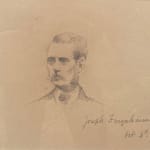Joseph Farquharson RA Scottish, 1846-1935
Self Portrait 1886
Pencil
Size without frame 6 x 8 ins
Size with frame 15 x 17 1/2 ins
Size with frame 15 x 17 1/2 ins
£ 1,500.00
Further images
Born Edinburgh 4th May; died Finzean, Aberdeenshire, 15th April. Painter in oil and sometimes watercolour of landscape, garden scenes, and occasional portraits. Renowned for his snow scenes. Son of Francis Farquharson, laird of Finzean and medical practitioner in Kincardineshire. Early days were spent in his father’s house in Northumberland Street below Queen Street Gardens and later at Eaton Terrace beyond the Dean Bridge, Edinburgh and at Finzean. Until he was 12, Joseph was allowed to paint only on Saturdays when he was permitted to use his father’s paints. On his twelfth birthday he was presented with his first box of paints, a gift he was quick to celebrate the following summer by submitting a picture to the Royal Scottish Academy which was accepted. The popular Scottish landscape painter and teacher Peter Graham was a family friend, under whose tutelage the young man studied for twelve years. Most of his early subjects were inspired by the countryside around his home. Aged 16 he entered the Board of Manufacturers School in Edinburgh under the guidance of Hodder and in 1880 studied in Paris under Carolus Duran. Between 1885 and 1893 he paid several visits to Egypt. Among the works exhibited at this time were ‘On the Banks of the Nile Outside Cairo’, and perhaps the best of his Egyptian work, ‘He Drove them Wandering o’er the Sandy Way’. His first major portrait was of ‘Miss Alice Farquhar’ exhibited in 1884. His first exhibit at the Royal Academy, ‘Day’s Dying Glow’, was in 1873. In common with other leading Aberdeen artists, eg John Philip and William Dyce, Edinburgh and Glasgow were leap-frogged in favour of London. Walter Sickert wrote an essay comparing Farquharson’s treatment of snow scenes to those of Courbet and praised the former’s lightness of touch, ‘the mark of the real painter’. Farquharson had a deep understanding of people as well as of landscape. The finest works often included a human figure, generally men and women of the land going about their daily labour. As he grew older his work became more impressionistic, less pictorially precise. The mood began to transcend the particulars. His place in British art is secure, no-one has painted the north-east of Scotland with greater integrity and understanding, nor with less pretence. He was a totally honest man, free from sycophancy, whose joy it was to portray the natural beauties around him and to let his paintings speak for themselves. Although pre-eminently a painter of winter landscapes his ability to catch the warmth and light, the sun-filled sandy atmosphere and the dazzling bazaars of north Africa as well as sunny autumn days in the Highlands are equally evocative. Elected ARA1890, RA 1915. In addition to exhibiting over 200 works at the RA he showed 73 works at the RSA, 32 at the Glasgow Institute, 47 in Liverpool and 181 works at the Fine Art Society, after 1916 from Finzean. Represented in the Tate, National Gallery of Scotland, Scottish National Portrait Gallery, Aberdeen Art Gallery, among others.
Self portraits of Joseph Farquharson are extremely rare, only two others extant, and both of these show Farquharson as an older man.
Self portraits of Joseph Farquharson are extremely rare, only two others extant, and both of these show Farquharson as an older man.
Join our mailing list
McEwan Gallery Newsletter
* denotes required fields
We will process the personal data you have supplied in accordance with our privacy policy (available on request). You can unsubscribe or change your preferences at any time by clicking the link in our emails.





